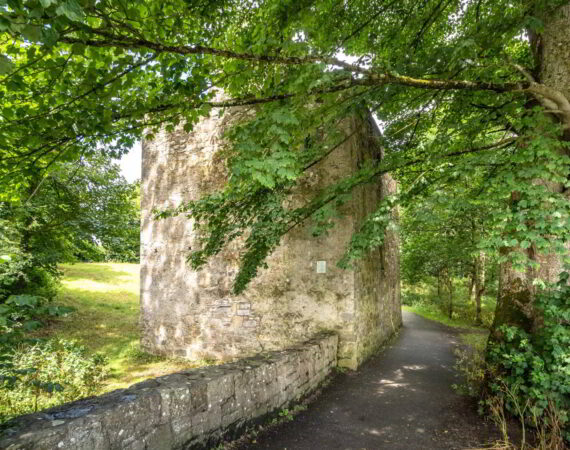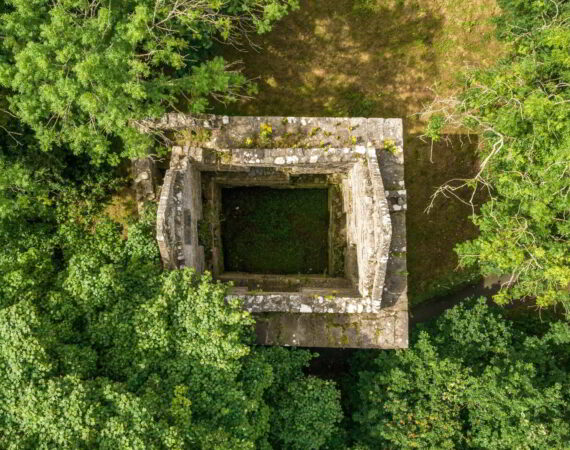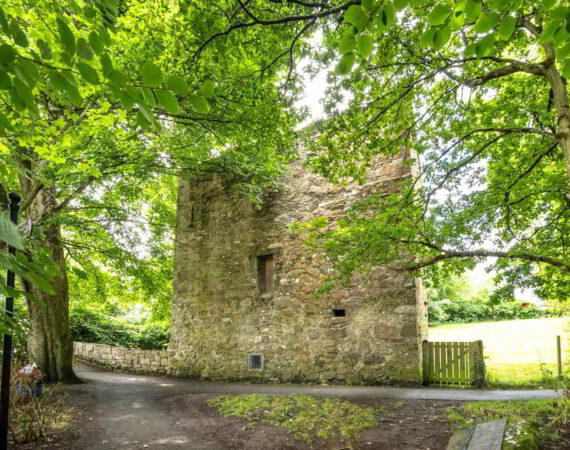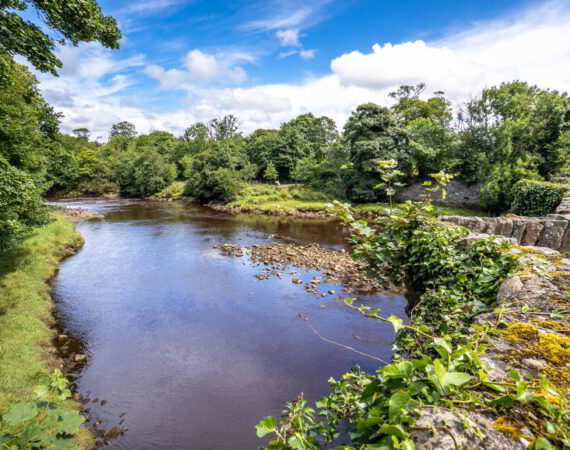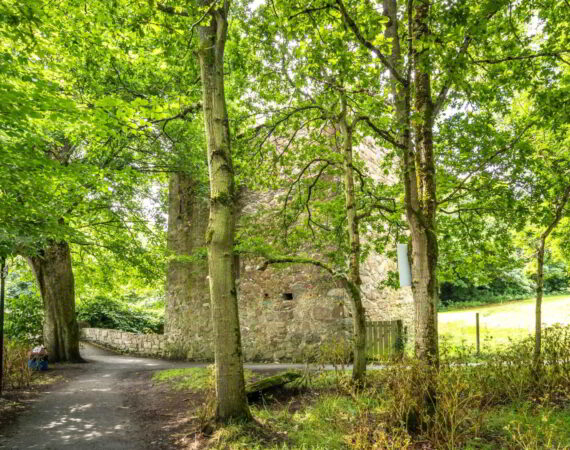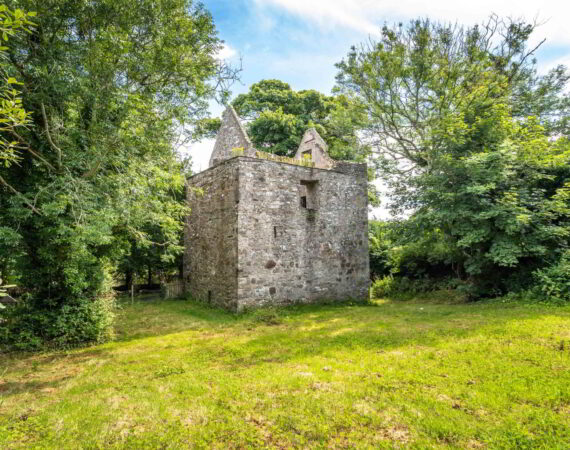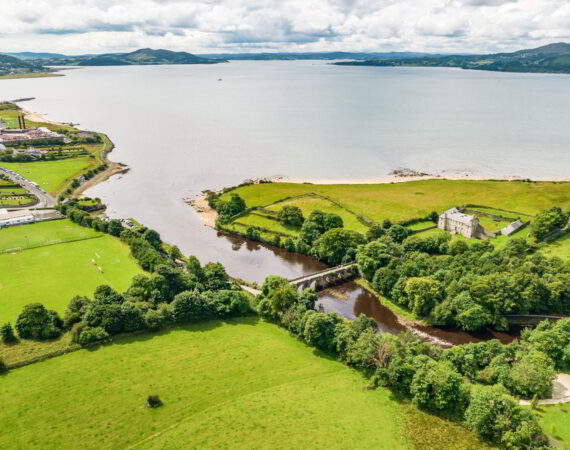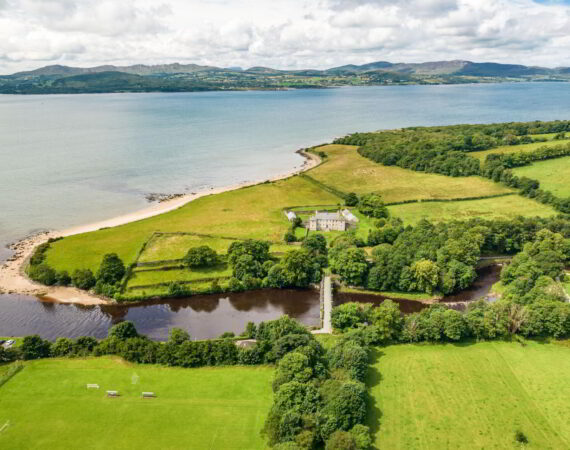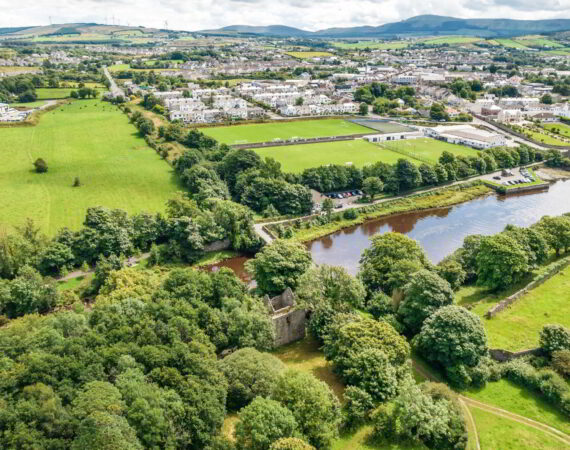O'Doherty's Keep, Buncrana, Co. Donegal
A ruined tower house on the banks of the River Crana stands as the symbol of the O'Doherty clan's 300-year rule over Inishowen.
O'Doherty's Keep, Buncrana, Co. Donegal
This weathered stone tower rising from the wooded banks of the River Crana tells a story of Gaelic lords, English conquest, and the dramatic reshaping of an entire town. Once the stronghold of the O’Doherty clan who ruled the Inishowen peninsula for three centuries, this tower house now stands quietly in Buncrana’s Swan Park, its roofless walls bearing witness to Ireland’s turbulent past.
From Gaelic Stronghold to Ruin
The O’Dohertys took control of Inishowen in the early 1300s, replacing the McLaughlin dynasty as the peninsula’s Gaelic rulers. While we don’t know exactly when they built this tower house, most archaeologists date the lower portions to the 15th century. The Normans may have built something here earlier; they’d spent most of the 1200s trying and failing to conquer Inishowen; but any trace of their work has long since vanished into the stonework.
The building isn’t technically a castle keep but rather a tower house, the fortified residence of choice for Ulster’s Gaelic chieftains during the late medieval period. This sub-rectangular structure measures roughly 9.9 by 8.6 metres and rises three storeys from a battered (sloped) base. Built from large stone blocks and rubble mortar, it exemplifies the defensive architecture typical of 15th-century Irish tower houses, though centuries of modifications have obscured many original features.
Defensive Design
The tower’s defensive elements tell a story of evolving military technology. The original ground floor entrance in the north wall featured classic defensive elements including a murder hole (an opening above the entrance where defenders could attack intruders) and a mural lobby built into the wall thickness. This doorway has since been blocked up and fitted with gun loops, narrow openings for firearms that reflect later adaptations to gunpowder warfare.
Today’s main entrance sits at first-floor level on the east wall, accessed by a stone mural staircase built into the eastern and southern walls. Each floor originally contained chambers lit by narrow loops or windows set in splayed embrasures (widening inwards to maximise light whilst minimising vulnerability). Many of these openings have been converted to fireplaces, blocked up, or modified with gun loops over the centuries, creating an architectural palimpsest of different eras and defensive needs.
Rebellion and Ruin
By 1601, the castle was described as a “small castle” belonging to Connor McGarrett O’Doherty. The tower’s most dramatic chapter came shortly after, when Hugh Boy O’Doherty carried out extensive repairs in 1602 during the Nine Years’ War, possibly preparing for promised Spanish military aid that never arrived. After his death, the tower became the chief residence of Sir Cahir O’Doherty, the last Gaelic Lord of Inishowen.
Cahir’s story reads like a Shakespearean tragedy. Once knighted by the English for his bravery, he later rebelled against the Crown in 1608, burning the city of Derry. The English response was swift and brutal; they captured and burnt O’Doherty’s Keep to the ground, executed Cahir for treason, and seized all of Inishowen from the clan. In the early 1900s, a local man named Harry Swan discovered a cache of swords, daggers, and pike heads beneath the keep, believed to be remnants of Cahir’s final stand.
The Plantation Years
After crushing the O’Doherty rebellion, the English Crown granted the keep and surrounding lands to Sir Arthur Chichester, architect of the Ulster Plantation. He immediately leased it to Captain Henry Vaughan, an English army officer who “stronglie rebuylded” the burnt ruins around 1611, adding an English-style parapet to the tower. Vaughan also likely constructed a new residence beside the keep during these early Plantation years.
The Vaughan family occupied the site until 1718, when George Vaughan built a more comfortable Georgian manor house next door (confusingly, this newer building is now called Buncrana Castle). Local tradition says he demolished the keep’s protective bawn to provide building stone for his new mansion. With the family relocated to their grand new home, the old tower house was abandoned and gradually fell into ruin.
Even more dramatically, Vaughan demolished the entire original village of Buncrana to make way for his manor and gardens, rebuilding the town on higher ground across the river, creating the layout of modern Buncrana we see today.
A Curious Location
Professor Alistair Rowan noted that the keep occupies “a curiously indefensible position” at the bottom of a small hill where the River Crana meets Lough Swilly. This puzzling placement has led to speculation about whether the site held symbolic rather than purely military significance for the O’Dohertys.
The impressive Castle Bridge, built around 1718 alongside the Vaughan manor, still spans the river next to a 600-year-old cobbled ford that flood waters revealed in 2017. The keep also has a connection to Wolfe Tone, founder of Irish Republicanism, who was reportedly held in its vicinity in 1798 before his trial for treason in Dublin.
A Monument to Contested Borderlands
The walls of O’Doherty’s Keep, repeatedly damaged and rebuilt, embody the cycles of conflict and reconstruction that characterised this corner of Donegal during the transition from medieval to early modern Ireland. The structure stands as a tangible reminder of Ulster’s contested borderlands, where Gaelic lords and English settlers vied for control through centuries of warfare, rebellion, and plantation.
Today, O’Doherty’s Keep is designated as a National Monument under state guardianship, one of the few remaining O’Doherty castles in Inishowen. For the O’Doherty diaspora scattered across the world, it remains a powerful symbol of identity and a tangible link to their ancestral homeland.
In September 2023, after being held by Ronald H.C. O’Doherty (a Buncrana resident who acquired it in 1969), the ruins were sold for an undisclosed sum.
Good to Know
The keep is located in Swan Park on the northwestern edge of Buncrana town, beside Castle Bridge and the entrance gates to the privately-owned Buncrana Castle. While you can view the exterior from the park and bridge area, there's no public access to the tower's interior. Limited parking is available along Castle Avenue near the bridge, with additional parking in Buncrana town centre, a short walk away. The site is particularly atmospheric in the early morning when mist rises from the River Crana.

